
Andrew’s Current Blog
Archived blogs chronicling 1492 from a bicultural perspective appear under 1492 Blogs.
Andrew’s Current Blog
Archived blogs chronicling 1492 from a bicultural perspective appear under 1492 Blogs.
St. Croix
After Guadeloupe, the fleet explored the archipelago of islands to the north. Columbus named one for the Virgin of another Spanish monastery, Montserrat, a second for the Virgin who worked miracles in Seville’s cathedral, Saint Antigua, and a third—as the day of...
On Sale Today!
At last! Columbus and Caonabó: 1493–1498 Retold goes on sale today! See the reviews of historians and others under Reviews, as well as purchase links to Amazon, Barnes & Noble, iBooks, and IndieBound (you select your participating independent bookstore)!
Guadeloupe
After Dominica and Marie-Galante, Columbus’s fleet anchored for a week (November 4–10, 1493) at the twin islands close to Marie-Galante that the Kalinago or Caribe inhabitants called Caloucaera and Couchoalaoua. Columbus named them as one—Santa María de Guadalupe...
Dominica and Marie-Galante
At 5 a.m. on November 3, 1493, 528 years ago today, a lookout on Columbus’s flagship, the María Galante, sighted a volcano topping the sea mist in the moonlight. By dawn, islands of the archipelago now known as the Lesser Antilles came into view, and Columbus directed...
Why retell the traditional “Columbus Story”?
For this Indigenous Peoples’ Day, I post a link to my article published yesterday on the History News Network explaining why I believe it’s important to retell the traditional “Columbus story” from both Taíno and European perspectives. HNN Article
Canary Islands, October 2–13, 1493
Columbus’s second fleet stopped over at Gran Canaria on October 2, 1493, where sugar was stocked and a leaking ship repaired, and then anchored in the tiny harbor at San Sebastián on Gomera on October 5, the latter shown in two photos below. Prior to his first voyage,...
Columbus’s Second Voyage Sails from Cádiz
For readers of Columbus and Caonabó (coming this November 9!), I now begin posting photos, historic sketches, or other images relating to key events depicted in the book. On September 25, 1493, 528 years ago today, Columbus’s second fleet of seventeen ships departed...
Isabella and Anacaona
Women rulers were uncommon in both Taíno chiefdoms and European kingdoms during the fifteenth century. Nevertheless, the events related in Columbus and Caonabó: 1493–1498 Retold were significantly shaped by two women renowned in history—Spain’s Queen Isabella and the...
The First Christian Missionary Efforts in “Española”
When authorizing Columbus’s second voyage, Spain’s Queen Isabella and King Ferdinand instructed him to convert “Española’s” peoples by all ways and means. Pope Alexander VI had pronounced that the Lord was pleased for barbarous nations to be overthrown and brought to...
Chief Caonabó, in Columbus’s Own Words
Contemporary Spanish chroniclers of 1492—including Bartolomé de Las Casas—relate information about Chief Caonabó’s personality and his battle against Columbus’s invasion of “Española.” Most chroniclers derived this information largely through conversations with...
